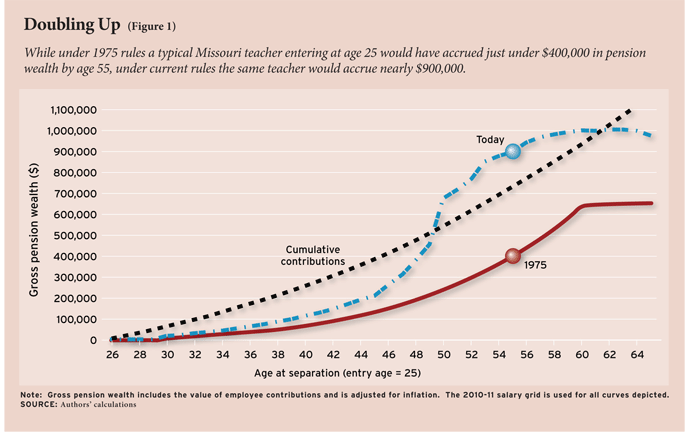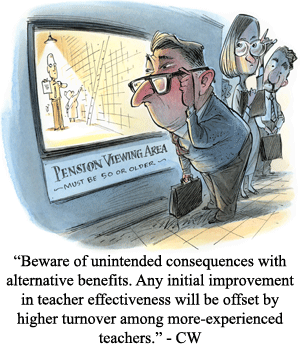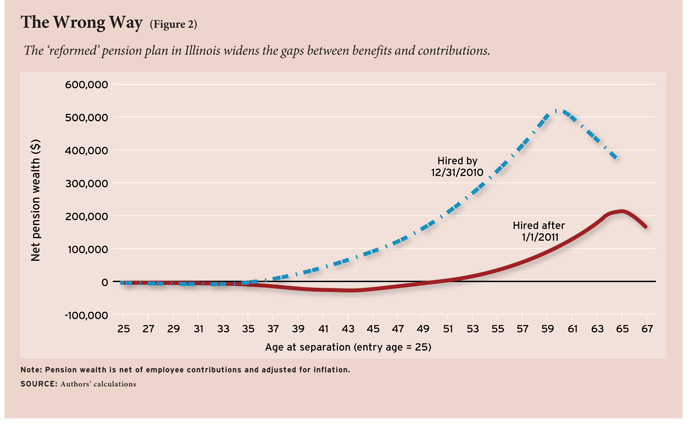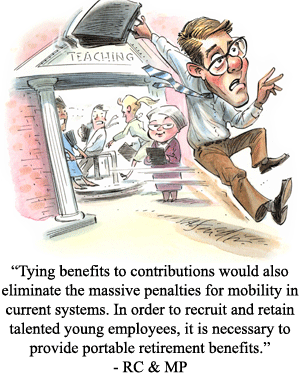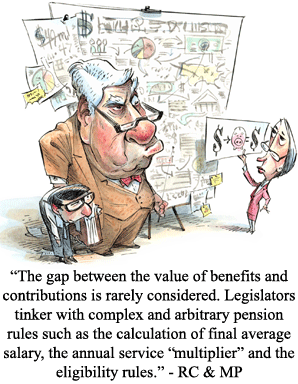Education Next talks with Robert M. Costrell, Michael Podgursky, and Christian E. Weller
Teacher benefits, once a sleepy question primarily of interest to actuaries, have become a flash point in the education debate. With individual states on the hook for tens or hundreds of millions in unfunded pension and health insurance obligations, state leaders are trying to determine the severity of the situation and the appropriate response. In this forum, Robert Costrell of the University of Arkansas and Mike Podgursky of the University of Missouri argue that the situation is critical, but offer an opportunity for overdue reform, while Christian Weller of the University of Massachusetts-Boston argues that measured steps will put teacher pensions on sound footing.
Education Next: How bad is the teacher pension crisis?
Christian Weller: The states’ fiscal crisis necessitates that they address pension underfunding. Underfunding means that pension assets are lower than liabilities, or those benefits promised to beneficiaries. The underfunding often seems staggering. The Center for Retirement Research at Boston College, for instance, estimated the gap at more than $700 billion in 2009. The aggregate underfunding reflects the money that states will need to come up with over several decades. But the CRR also estimates that an additional 2 percent of payroll would cover the expected shortfall, making the problem manageable without ruining governments.

States can take a balanced approach to managing pension underfunding that fits their particular circumstances. Thirty-nine states reduced benefits, increased contributions, or both between 2001 and 2009, according to the Pew Center on the States. The exact combination of benefit and tax changes depends on several factors, including public employees’ Social Security coverage, current benefits and contributions, and states’ human resource needs. States still want to make sure that their benefits allow them to hire the most-effective employees.
Robert Costrell and Michael Podgursky:
Indeed, educator pension systems are becoming increasingly expensive and, in many states, are seriously underfunded (see “Teacher Retirement Benefits,” research, Spring 2009). One major source of this problem is the massive increase in benefits from several decades of legislative enhancements. The key to understanding this is the concept of “pension wealth,” the current dollar value of the expected stream of future benefits, in other words, the cash value of a retiree’s annuity. Pension wealth encompasses both the annual pension payment and, importantly, the number of years it is collected.
The two solid curves in Figure 1 show pension wealth for a typical Missouri teacher in 1975 and today. Each curve is calculated under the current salary schedule for teachers in the state capital, so the growth represents only pension rule changes. The bottom curve shows that under 1975 rules a teacher entering at age 25 would have accrued just under $400,000 in pension wealth by age 55. Today, the same teacher would have accrued pension wealth of just under $900,000 by the same age. Not surprisingly, these enhancements have come at a substantial cost: Combined contributions for teachers and districts increased from 16 to 29 percent of salary over this period. However, even this is inadequate; the portion of salary required to pay for pension wealth accruals of current teachers and to pay off the unfunded liability is 31.3 percent.
EN: What steps should states take to address the crisis?
RC & MP: Given concerns about cost and long-term sustainability, a number of states have cut benefits, usually for new teachers, and others are considering doing so. However, in making these changes, policymakers should carefully consider their labor market effects. Some of the proposed cuts reproduce, and even exacerbate, undesirable features of current systems. These shortcomings stem from a fundamental flaw: the failure to tie benefits to contributions. Thus the fix must expose and eliminate the gaps between the two. Below are three recommendations for reforming teacher pensions:

1. Report the gaps between contributions and pension wealth. In many respects, current defined benefit (DB) pension plans for teachers are opaque. Teachers rarely know what their plan is worth. By contrast, holders of 403(b) or 401(k) accounts typically know exactly what their account is worth at any point in time. To provide the same transparency for teachers, plans should not only disclose the projected annual pension payment, they should also report pension wealth. For comparison, the plan should disclose the cumulative value of contributions, both the employee’s and the employer’s, along with accumulated returns. In this way, each educator could see how the value of her accrued benefits compares with the value of the contributions. In the typical teacher pension plan, these are going to be very different numbers. Early in a teacher’s career, the value of the contributions will far exceed pension wealth, whereas for more senior teachers, the reverse is true. The dotted line in Figure 1 illustrates this point. It represents the cumulative value of contributions that is fiscally equivalent to the current pension plan, showing that the cumulative value of pension contributions exceeds pension wealth until age 50. However, between ages 50 and 62 pension wealth is typically well in excess of contributions. Not surprisingly, this is when the vast majority of full-career teachers choose to retire.

2. Close the gaps between contributions and pension wealth. To make pensions more equitable and effective tools for staffing schools, we propose that retirement benefits paid to any teacher should be tied to the lifetime contributions made by or for that teacher. If $300,000 has been contributed on behalf of a teacher (including accumulated returns), then the cash value of an annuity provided to this teacher should also be $300,000.
Unfortunately, as we have seen, this fundamental principle is routinely violated in teacher plans. The gap (positive or negative) between the value of benefits and contributions is rarely considered in plan design. Instead, legislatures tinker with complex and arbitrary pension rules, such as the calculation of final average salary (how many years included, what counts as “salary”), the annual service “multiplier,” and the eligibility rules to receive the pension (“rule of 80,” “25-and-out,” etc.). Since these benefit rules are not tied to contributions, legislatures have, over the years, enhanced them, without regard to equity or efficiency, and often without adequate funding. These complex rules also encourage “gaming” by educators and districts in order to increase the gap between benefits and contributions.
Our analysis shows that current systems typically result in very large implicit transfers from young teachers working short spells to “long termers,” who work full careers in the same system (see “Golden Handcuffs,” research, Winter 2010). In our view, a teacher who works 10 years or 30 years should accrue pension wealth roughly equivalent to total pension contributions (with accumulated returns). Thus, in Figure 1, the pension wealth curve would coincide with the contributions curve depicted, for a fiscally equivalent plan, or with a lower curve if costs are to be reduced.
In addition to improving equity, tying benefits to contributions would have important workforce benefits. First, it would provide rational incentives for retirement versus continued work. Each year, an educator would accrue pension wealth in a smooth and transparent way, providing a steady addition to the annual salary she is earning. This would generate neutral incentives to work or retire based on individual preferences and effectiveness. That is not the case with current systems. In our own work, we have shown sharp “peaks and valleys” in pension wealth accrual, which distort incentives for retirement (see “Peaks, Cliffs, and Valleys,” features, Winter 2008). Some years (e.g., at 25 or 30 years of service) yield increases in pension wealth that are several times the teacher’s salary. This provides a huge incentive to stay on the job until that pension “spike,” regardless of classroom effectiveness. There is no economic rationale for favoring one year of work over another in this way. Nor should an additional year of work reduce pension wealth (net of employee contributions), as is the case in current teacher plans after a certain point, often at relatively young ages. This penalizes good teachers who wish to stay.
Tying benefits to contributions would also eliminate the massive penalties for mobility in current systems. It is well understood in the private sector that in order to recruit and retain talented young employees it is necessary to provide portable retirement benefits. This is accomplished by defined contribution (DC) or cash balance (CB) plans that vest immediately or nearly so. Current teacher plans typically have 5- and even 10-year vesting. Our research finds that even for vested educators, the loss in pension wealth for those who split a teaching career between two traditional plans is massive. In a system where benefits are tied to the cumulative value of contributions, it does not matter whether contributions have all been made in one or many jobs: Penalties for mobility are eliminated.
3. There is more than one way to do it right—and to do it wrong. We favor CB plans. These are a form of defined benefit plans that generate individual retirement accounts in bookkeeping form within the pension fund. They are funded by contributions from employer and employee just like most current teacher plans and carry an investment return guaranteed by the employer. Such plans resemble a DC plan, but without transferring investment risk or asset management to the teacher. They are transparent, offer smooth wealth accrual, and are readily turned into annuities at retirement, like traditional teacher plans. However, no one year of retirement is favored over any other. Large private employers such as IBM have converted to such plans, as have a few public employers. The TIAA guaranteed-return plans that are common in higher education are similar in operation. They have provided retirement security for generations of college professors, who often spread careers over multiple institutions.
By contrast, Illinois is a cautionary example of how not to reform teacher pensions. Illinois recently implemented a two-tiered plan, placing teachers hired after January 1, 2011, in the second tier. Tier 2 teachers make identical contributions (9.4 percent) as their Tier 1 colleagues, but take a drastic cut in pension wealth accrual over their work lives, as shown in Figure 2. The Tier 2 plan retains the same basic structure while raising the retirement age. This exacerbates the back-loading and mobility penalties, and widens the gaps between benefits and contributions. A new teacher entering the Illinois plan at age 25 will accrue no pension wealth, net of employee contributions, until age 51. This is not an attractive offer for young, mobile teachers. Indeed, the Tier 2 package is not actually a net “benefit” for entering teachers, since the teacher contributions are nearly double the cost of the average benefit they accrue; the rest is basically a tax to pay for benefits accrued but not funded, by previous cohorts of teachers.
As states grapple with the current pension crisis, a window of opportunity is open to implement more modern and strategic plans, or to make matters worse. Fundamental reforms are needed to fix these broken systems. Systems should first be required to report the gaps between benefits and contributions for all members. Then, as a matter of equity and efficiency, the plans should be restructured to close these gaps by tying benefits to contributions. This would give young teachers their fair share of the retirement benefit pie and rationalize the retirement incentives for all teachers.
CW: States can take a number of steps to alleviate the pension crisis:
1. Spread the pain of addressing underfunding, if adjustments are unavoidable. Changes to pension plans generally only apply to new hires. State constitutions and courts typically hold already-earned benefits and future not-yet-earned benefits for existing employees and beneficiaries inviolate. This protection is also occasionally applied to employee contributions. Governments cannot reduce benefits and raise contributions for current employees, even if they want to. Hence, adjustments fall disproportionately on new hires.
Private-sector pension benefits also enjoy substantial protections, but to a lesser degree than public-sector benefits. The Employee Retirement Income Security Act of 1974 protects from reductions benefits that have already been earned, but it does not protect future benefits not yet earned. Private-sector employers can thus lower future benefits when a crisis requires a drastic change.
States should change their public benefit protections to permit adjustments to be distributed across a broader range of employees, if such adjustments become necessary. States could guarantee already-earned benefits but not those not yet earned, as the private sector does. States could also ease older employees’ distress about potential benefit changes by allowing future benefit reductions only for employees under a certain age.
There are several advantages to this approach: Current beneficiaries would remain fully protected, already-earned benefits could not be taken away, and older employees would receive the retirement benefits that they had earned. Arbitrary divisions in younger employees’ compensation arising from whether they were hired before or after the benefit change went into effect would also be eliminated.
2. Prevent underfunding in the future. The current underfunding resulted from massive stock and real-estate market declines. Public pensions were prudently managed before the crisis, as Jeff Wenger and Christian Weller have demonstrated elsewhere.
But many governments did not contribute as much as necessary to their pension funds, making them vulnerable in a crisis. The problems of pensions are more a result of low employer contributions than poor pension management. Governments often avoided paying the full amount of what was necessary to cover benefits earned in a given year. Even in 2011, Governor Chris Christie (R-NJ) considers the state’s contributions to its pension plan an optional expense. Governments, as employers, have exacerbated, and continue to exacerbate, their pension plans’ financial challenges.
One solution is to make governments pay the necessary amount to their pension plans. States could set a floor under employer pension contributions. The employer contributions could never fall to zero, commonly known as “taking a contribution holiday,” and employer contributions could never fall below the “floor” rate. DB pensions would receive money more regularly than is currently the case and thus underfunding would become less likely, particularly during a crisis.
If they set a floor for employer pension contributions, states would simultaneously have to change the rules that govern pension funding. Strong financial market performance could easily translate into overfunded pensions, which is desirable, since it means that DB pensions are prepared for a rainy day, such as the recent crisis. But overfunded plans could feed appetites for benefit improvements or contribution cuts, unless the law states that better benefits and lower contributions could only be considered if a DB pension has a minimum buffer for emergencies. Weller and Baker (2005) suggest a buffer of 20 percent of liabilities, which could be even smaller for state DB pension plans, since states cannot go bankrupt.
3. Beware of unintended consequences with alternative benefits. The wrong changes could have serious adverse effects. This would be the case if states also changed their retirement plans from DB pensions to an alternative design, particularly defined contribution (DC) savings accounts such as 403(b) plans, but also a cash balance plan. Cash balance plans look like DC plans to employees but operate like a DB pension for employers. Employers offer a guaranteed rate of return on current and past contributions to a cash balance plan and take the risk of higher contributions if the actual rate of return falls below the promised one.
Alternative benefits are less efficient than DB pensions. First, the average teacher effectiveness will likely decrease, as much higher employee turnover will easily offset any potential effectiveness gains. Second, alternative benefits come with substantial costs.
One unproven assertion about alternative benefits is that they would result in greater teacher effectiveness. Alternative retirement benefits are attractive to their proponents because these benefits would offer more compensation earlier in a teacher’s career and promote turnover later in a teacher’s career relative to a DB pension. Higher compensation earlier would attract to the profession people who could potentially become more-effective teachers, while fewer financial incentives to stay would supposedly lead ineffective teachers to leave earlier than they otherwise would.
The literature on teacher effectiveness and employee turnover associated with benefits shows that average teacher effectiveness will likely decline with alternative benefits. Higher early compensation will offer only a small incentive for promising though untested teachers to enter the profession. And the link between teacher pay and student achievement has been shown to be tentative at best. Since a benefit change would only marginally increase beginning teachers’ compensation, any initial bump in overall instructional effectiveness would be both fleeting and faint, if it exists at all. Any small initial improvement in teacher effectiveness will be quickly offset by higher turnover among more-experienced teachers. Experienced teachers who leave will be replaced by inexperienced teachers, who will need time to build their classroom skills. Small turnover increases can quickly offset small productivity gains to ultimately lower average teacher quality. The literature, in fact, shows that we can expect substantial increases in turnover with a switch to DC and cash balance plans from DB pensions so that higher turnover will eliminate any possible gains from higher initial compensation. We estimate, for instance, that the chance of worsening teacher effectiveness is about 60 percent with a cash balance plan and 70 percent with a DC plan under optimistic assumptions that favor alternative benefit designs based on the existing long-standing literature on pensions and turnover and the much smaller literature on initial compensation and teacher effectiveness.
Teacher turnover can be expected to increase with alternative benefits because employees will understand that their economic security is less well protected with a DC or cash balance plan than with a DB pension. National opinion polls routinely find very strong support for DB pensions, as individuals who do not like risk prefer to have some income guarantees for themselves and their families when they retire, become disabled, or pass away. Fewer income guarantees, or insurance, lead people to leave employment more quickly than they otherwise would. Thus, under these circumstances, teacher turnover would increase and average teacher effectiveness would fall.
Private-sector employers without DB pensions often use other tools to mirror the human resource effects, i.e., long tenure of skilled workers, of DB pensions, exactly because they are worried about turnover. Employers in the field of information technology, especially, offer, for instance, stock options and stock grants to recruit and retain skilled workers for long periods of time. States simply cannot offer these benefits and hence have no way to lower turnover among effective employees.
Alternative benefits also cost more. First, DB pensions would have to operate with a finite investment horizon, increasingly moving money to secure, low-return assets so that lower investment earnings would lend less of a helping hand to pay for benefits. Second, employers may have to cover any underfunding more quickly for closed plans than for ongoing ones, raising employer contributions. Third, higher turnover increases cost due to more recruitment and training of new hires. Fourth, there are substantial transition costs. Older employees will continue to earn DB pensions, they will earn more benefits as they stay longer on the job, and there will be more long-term employees under the DB pension, raising the cost per employee of the DB pension. New employees, in comparison, would be more prevalent in the new plan, earn initially higher benefits than with a DB pension, and thus raise costs relative to a DB pension. These transition costs would last for about four decades and could average 1 percent of payroll for many years, even if the costs of retirement benefits are the same before and after the transition. Fifth, DC plans offer fewer insurance benefits than DB pensions. The insurance exists largely because employees who happen to live through a prolonged period of prosperity share some of their gains with less fortunate employees. Researchers at the National Institute on Retirement Security estimated in 2008 that the loss of insurance features meant that each dollar invested in a DC plan generated 46 percent less in retirement benefits than a dollar invested in a DB pension. Finally, there are higher administrative costs due to a large number of small accounts, especially in DC plans, and increased movement of money between retirement plans.
The two states that have switched from DB pensions to DC plans, West Virginia and Alaska, had severe cases of buyers’ remorse. West Virginia eventually switched back to a DB plan for their teachers in 2008, and Alaska’s policymakers have been investigating the possibility of making a similar reversal.
The lessons from the evidence are clear: States can manage the financial challenges of their pension plans. The proposal to use the current crisis as an opportunity to switch retirement plans, though, will leave states with a much less efficient compensation system. The average effectiveness of teachers will likely drop, and costs will go up substantially. States will be better off managing the financial problems of their DB pensions by putting mechanisms in place that will prevent future underfunding instead of engaging in costly retirement-plan experiments that offer no benefits.
EN: What, then, are the main areas of disagreement?
RC & MP: We disagree on structure. We argue that benefits should be tied to contributions. Professor Weller believes this would have adverse consequences.
Weller assumes a shift to CB or DC would raise annual exits at all ages by a hefty rate, between 22 and 220 percent, according to his recent but as yet unpublished paper on which his efficiency claim is based. Thus, the share of novice teachers in the workforce would rise and average effectiveness would fall. However, the 22 percent estimate is drawn from a 1993 paper by Allen, Clark, and McDermed that compares private-sector workers “covered by a company retirement plan” to those who were not covered by any plan, so there are no implications for CB or DC. The 220 percent assumption is drawn from a 1996 paper by Even and MacPherson that actually shows no difference in quit rates between DB and DC.
Economic theory suggests mixed effects of CB on teacher quit rates, raising them for mid-career teachers who would otherwise hang on for early retirement and lowering them for late-career teachers, otherwise driven out by negative accrual. It might also lower quit rates for young teachers, since they accrue more pension wealth under CB than under current plans. This mixed pattern is supported by Costrell and McGee’s findings, in their 2010 peer-reviewed econometric study of teacher response to pension wealth accrual. Their simulation of a shift to CB, based on their behavioral estimates, found a slight rise in average teacher tenure, not a large fall.
Turning to transition costs, Weller claims that new plans raise costs on old plans by forcing changes in investment strategy or amortization schedules. However, pension plans often introduce new “tiers” without these effects, as new and old funds are commingled. Introducing CB as a new tier would be no different.
Weller’s simulation of transition costs, also from his unpublished paper, makes a different argument. He claims costs will rise for decades because entering cohorts have a different time pattern of pension wealth accrual than previous cohorts. But the time pattern is irrelevant here. Each cohort’s cost is the present value of its lifetime accruals, however they are distributed. Costs cannot rise unless some cohort enjoys higher benefits and, hence, higher lifetime accruals of pension wealth. Yet Weller assumes each cohort accrues the same pension wealth—10.25 percent of the cohort’s lifetime payroll. That is the cohort’s “normal cost,” the contributions required to fund the cohort’s lifetime benefits and accruals. The system’s required contributions are a blend of each cohort’s normal costs, but these are the same, 10.25 percent for each cohort. Thus, the system’s contributions are unchanged, and there are no transition costs.
Costs and contributions would fall if benefits were cut, as Weller recommends. Indeed, they would fall more quickly under his reasonable proposal to cut normal costs of current teachers, as a matter of equity between generations. However, we also favor equity for mobile young teachers, who will continue to receive benefits worth far less than contributions, absent fundamental reform.
CW: The evidence shows that defined benefit pensions work for education. Professors Costrell and Podgursky do not address the fact that both employers and employees prefer defined benefit pensions over other retirement benefits.
The vast majority of states underwent pension reforms in the past decade to address the financial challenges of pension underfunding and none abandoned their defined benefit pensions. And private-sector employers in key growth industries, such as information technology and banking, offer either defined benefit pensions or other forms of deferred compensation, such as stock options, to their employees to mimic the retention benefits of pensions when pensions are absent. A substantial literature both develops the theory and shows the supporting evidence for the efficacy of deferred compensation as a retention and recruitment tool for skilled employees. There is a clear economic rationale for deferred compensation, since it allows employers to recoup the investments made in hiring and training skilled employees, such as teachers.
Teachers equally prefer pensions. Opinion polls routinely show a preference for defined benefit pensions, even among younger employees. And when teachers (and other public employees) have been given a choice between defined benefit pensions and defined contribution plans, the vast majority typically chooses the defined benefit pension plan. The evidence contradicts Professors Costrell and Podgursky’s key assertion that alternative plans that offer more immediate compensation are more attractive to younger teachers.
Finally, transition costs from a defined benefit pension to a cash balance plan would quickly drain public coffers. There would be a growing concentration of more-experienced teachers under the defined benefit pension that favors more-experienced teachers and a high concentration of inexperienced teachers under a cash balance plan that favors inexperienced teachers. A long-standing literature has regularly shown that DB pensions substantially reduce turnover compared to other retirement benefits, suggesting that a benefit switch will increase turnover.
The increase in turnover will raise costs and pose the threat of lower average effectiveness, as my own simulations for a switch from DB pensions to cash balance plans show. The costs are predictable and substantial, while any benefits are highly uncertain and likely nonexistent.
This article appeared in the Fall 2011 issue of Education Next. Suggested citation format:
Costrell, R.M., Podgursky, M., and Weller, C.E. (2011). Fixing Teacher Pensions: Is it enough to adjust existing plans? Education Next, 11(4), 60-69.



